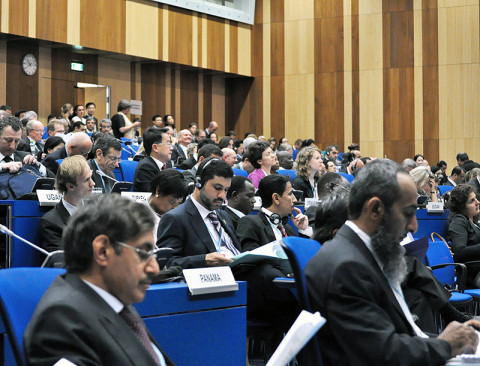Written by Dr. Tony Phillips
Science at NASA
 Washington, D.C. – Rewind to the late 1950s. The Soviet Union had just launched the first artificial satellite, Sputnik. The United States, caught short, was scrambling to catch up, kick-starting a Cold War space race that would last for decades. Space was up for grabs, and it seemed like anything could happen.
Washington, D.C. – Rewind to the late 1950s. The Soviet Union had just launched the first artificial satellite, Sputnik. The United States, caught short, was scrambling to catch up, kick-starting a Cold War space race that would last for decades. Space was up for grabs, and it seemed like anything could happen.
Into this void stepped the United Nations. In 1958, the General Assembly “recognizing the common interest of mankind in furthering the peaceful use of outer space … and desiring to avoid the extension of present national rivalries into this new field….” established the Committee on the Peaceful Uses of Outer Space (COPUOS).

As the years went by, COPUOS membership ballooned from 18 to 74 nations, while items such as space debris, near-Earth asteroids, space-based disaster management, and global navigation were added to the committee’s regular agenda. At each annual meeting in Vienna, Austria, COPUOS members confer about these issues, which present some key challenge or peril to the whole planet.
This year, a new item is on the agenda: Space Weather.
“This is a significant development,” says Lika Guhathakurta of NASA Headquarters in Washington. “By adding space weather to the regular agenda of the COPUOS Science and Technical Subcommittee, the UN is recognizing solar activity as a concern on par with orbital debris and close-approaching asteroids.”

Space weather is the outer-space equivalent of weather on Earth. Instead of wind, rain and snow, however, space has radiation storms, the solar wind, flares and coronal mass ejections. The source of space weather is the sun, and although solar storms are launched 93 million miles from Earth, they can make themselves felt on our planet.
“Strong solar storms can knock out power, disable satellites, and scramble GPS,” says Guhathakurta. “It’s a global problem made worse by increasing worldwide reliance on sensitive electronic technologies.”
Solar energetic particles at the magnetic poles can force the re-routing of international airline flights resulting in delays and increased fuel consumption. Ground induced currents generated by magnetic storms can damage transformers and increase corrosion in critical energy pipelines.
“Space weather is a significant natural hazard that requires global preparedness,” says Prof. Hans Haubold of the UN Office for Outer Space Affairs. “This new agenda item links space science and space technology for the benefit of all humankind.”
The elevation of space weather on COPUOS’s agenda coincides with the 10th anniversary of the International Living With a Star Program on February 14th. The program is an ad hoc group of nations that got together in 2003 to lay the groundwork for worldwide cooperation in the study of space weather. The UN will help take their efforts to the next level.
A key problem that the UN can help solve is a gap–many gaps, actually–in storm coverage around our planet. When a solar storm sweeps past Earth, waves of ionization ripple through Earth’s upper atmosphere, electric currents flow through the topsoil, and the whole planet’s magnetic field begins to shake.
“These are global phenomena,” says Guhathakurta, “so we need to be able to monitor them all around the world.”
Industrialized countries tend to have an abundance of monitoring stations. They can keep track of local magnetism, ground currents, and ionization, and provide the data to researchers. Developing countries are where the gaps are, particularly at low latitudes around Earth’s magnetic equator. With assistance from the UN, researchers may be able to extend sensor networks into regions where it was once politically unfeasible.
“The new permanent agenda item of the Science and Technology Subcommittee is an important opportunity to harness the effort of all Members to ensure coordinated global action,” comments Terry Onsager of the United States’ National Oceanic and Atmospheric Administration (NOAA).
Now that space weather has been elevated to a permanent place on the COPUOS agenda, it will be a matter of regular conversation among UN diplomats, scientists and emergency planners. This is important because, while space is no longer up for grabs, it is still true that in the realm of space weather almost anything can happen.
Learn more about the Committee on Peaceful Uses of Outer Space at: http://www.oosa.unvienna.org/oosa/COPUOS/copuos.html


